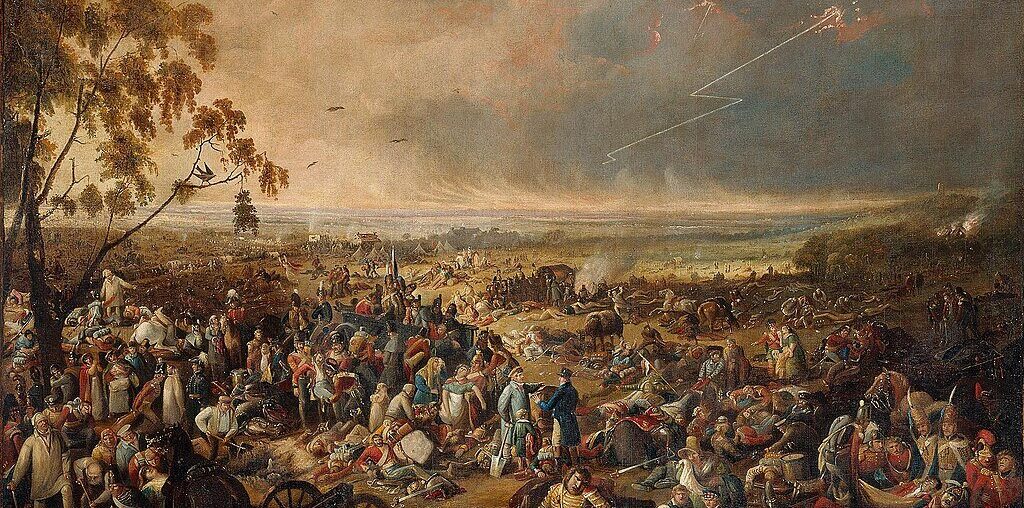The morning after the Battle of Waterloo on June 19, 1815. By John Heaviside Clark.
The Carnage of Waterloo: A Battlefield of Corpses
The Battle of Waterloo was a clash of titans, with Napoleon’s Armée du Nord pitted against the combined forces of the Seventh Coalition, led by the Duke of Wellington and Prussian Field Marshal von Blücher. The battle raged for eight grueling hours, culminating in a decisive victory for the Coalition. In the immediate aftermath, the battlefield was a harrowing sight. Contemporary accounts describe piles of corpses, wounded soldiers left untreated, and the pervasive stench of death.
Major W.E. Frye, who visited the battlefield just days after the fighting ceased, recounted “a sight too horrible to behold” with “heaps of wounded men with mangled limbs” and a multitude of carcasses. These vivid descriptions paint a picture of immense loss and devastation, yet they also underscore a mystery: where are all the bodies now?
The 19th Century Bone Rush: A Macabre Industry
In the decades following the battle, Europe experienced a peculiar and macabre industry boom, the trade of human bones. It was common practice to use bones as a source of phosphate fertilizer, a crucial component for the agricultural revolution of the 19th century. Historical records indicate that bones were collected from battlefields across Europe, ground into bone meal, and transported primarily to Britain, where they were in high demand.
The industrial use of bones extended beyond agriculture. The sugar industry, in particular, utilized bones in a process known as bone black or bone char filtration. This involved burning bones to create a porous, carbon-rich substance that could decolorize sugar during the refining process. The demand for bone char was significant, as it produced a higher quality of refined sugar, which was essential for the growing consumer markets in Europe and America.
Professor Tony Pollard of the University of Glasgow, a leading expert in battlefield archaeology, has extensively studied this phenomenon. Pollard’s research, published in the Journal of Conflict Archaeology, suggests that Waterloo, with its high concentration of casualties, was a prime target for this gruesome trade. He points to newspaper articles from the 1820s, such as one from The London Observer, which reported that “more than a million bushels of ‘human and inhuman bones’” were imported from European battlefields into the port of Hull.
These bones likely served dual purposes: providing phosphate fertilizer for agriculture and supplying the bone char needed for sugar refining. This dual use underscores the macabre efficiency of the bone trade and highlights the economic incentives that drove the harvesting of human remains from battlefields like Waterloo.
A Missing Piece of History: The Search for Mass Graves
Pollard’s investigation into the Waterloo battlefield has been driven by a combination of historical accounts, memoirs, and early visitor descriptions. These sources frequently mention the presence of mass graves. For instance, several accounts describe mass burials at Hougoumont, a key location in the battle. Yet, despite these reports, no substantial human remains have been discovered in modern excavations.
In an attempt to uncover the truth, Pollard and his team, through the organization Waterloo Uncovered, have embarked on a multi-year geophysical survey. This initiative aims to locate grave sites that correspond with historical descriptions. The hope is that even if the bones were removed, there would still be archaeological evidence of the pits where they were buried.
Expert Opinions and Alternative Explanations
While Pollard’s theory is compelling, it remains a topic of debate among historians and archaeologists. Some experts suggest alternative explanations for the missing bodies. For example, it is possible that many of the dead were buried in shallow graves, which over time, could have been disturbed by agricultural activity or natural decomposition processes. Others argue that some bodies may have been incinerated in the aftermath of the battle, a practice not uncommon in the Napoleonic Wars.
Dr. Dominique Bosquet, an archaeologist with the Walloon Heritage Agency, emphasizes the need for direct evidence. “While the theory of bone collection is plausible given the historical context, we need more concrete archaeological evidence to confirm it definitively,” he says. This sentiment is echoed by other scholars who call for continued excavation and analysis.
Conclusion: A Tale Yet Unfinished
The mystery of Waterloo’s missing dead is a poignant reminder of the human cost of war and the complexities of historical research. While the theory that soldiers’ bones were collected and sold as fertilizer is supported by compelling circumstantial evidence, definitive proof remains elusive. As Pollard and his team continue their work, the world watches with bated breath, hoping for answers to this macabre historical puzzle.
The investigation into the fate of Waterloo’s fallen soldiers underscores the importance of interdisciplinary research, combining historical accounts with modern archaeological techniques. It is a journey into the past that may one day reveal the final resting places of those who gave their lives on that fateful day in June 1815.
Richard Clements in his own words:
I am a dedicated writer with a passion for history and uncovering its mysteries. I specialize in creating engaging and well-researched content that brings historical events and intriguing mysteries to life. With a keen eye for detail and a love for storytelling, I have written on various historical topics, from ancient civilizations to modern history. My work aims to captivate readers and provide them with a deeper understanding of the past and the mysteries that intrigue us. He posts on X/Twitter here.
References
Pollard, Tony. “The Archaeology of Waterloo: Mapping the Missing Mass Graves.” Journal of Conflict Archaeology, vol. 6, no. 1, 2022.
Frye, Major W.E. Aftermath of Waterloo: An Eyewitness Account. Historical Press, 1817.
“More than a Million Bushels of Bones Imported into Hull.” The London Observer, 1822.
Bosquet, Dominique. “Excavations at Waterloo: An Ongoing Search for Truth.” Archaeology Today, vol. 12, no. 4, 2023.
University of Glasgow Press Release, 2015. “New Discoveries at the Waterloo Battlefield.”

